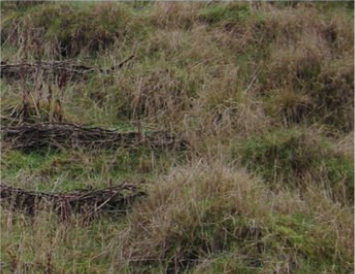Houses at the bottom of Langfield Common in Lumbutts were flooded with run off from the Common in the Christmas Day/Boxing Day floods.
With a resident whose house had been flooded, I recently went for a walk on Langfield Common to start looking at the potential for using natural flood alleviation measures, like those used in the Stroud Rural Sustainable Drainage System (SUDS).
A presentation on the Stroud Rural SUDs at the Green Party Spring Conference explained that this had started with people walking the streams and watercourses to their sources, and looking for places where various natural flood management methods could be used to slow and disperse the flow.
So this was what we did – although we didn’t get right to the top of the hill and the source of the watercourses. That needs another visit.
Although the whole hillside was soaked, and small and large chunks of it were eroded and being washed away, it was possible to see from reeds, pools and streams where the main watercourses flow down the hill, and to start imagining how natural flood management measures could be used to slow and disperse the flow.



 It was also evident where erosion control techniques like fascines could both repair erosion and slow the flow. Like the work Treesponsibility and Blackbark are doing.
It was also evident where erosion control techniques like fascines could both repair erosion and slow the flow. Like the work Treesponsibility and Blackbark are doing.
The issue is, who would do this?
A Langfield Common management group seems to have been formed to agree and manage a Higher Level Stewardship (HLS) and Upland Entry Level Scheme (UELS) contract with Natural England. Rural Futures says it is providing administration services to monitor capital works, submit claims and distribute annual payments throughout the lifetime of the agreement.
The Higher Level Stewardship and Upland Entry Level Scheme agreement is worth £528,000 over the 10 period, with a further £209,000 of capital payments for walling, footpath and peat restoration.
I think the 10 year period started in 2011, according to information on the Moors for the Future website.
The agreement aims to benefit the upland heath and moorland vegetation, wet and dry moorland and rough grazing, blanket bog, historic features and important bird species including curlew, snipe, twite, ring ousel, golden plover and merlin. The heather restoration works included in the annual burning plan has been agreed with funding for this activity. Sustainable stocking levels have been negotiated with active graziers and compensation allowances established for all right holders.
The 595 hectare Langfield Common includes a number of important vegetation mosaics, providing habitat for numerous plants and bird species. The common is a designated Site of Special Scientific Interest (SSSI), a Special Protection Area (SPA) and a Special Conservation Area (SCA).
The freeholders of Langfield Common are also partners in the South Pennines Commons Project, funded by Natural England. The aim was that by March 2015, project would have carried out the following measures:
- Revegetation of all areas of bare peat by spreading heather brash, plant plugs and reseeding
- Control of grazing levels by the introduction of fencing to allow differential grazing on the commons
- Reintroduction of growing sphagnum to start active blanket bog formation
- Safeguarding archaeological interest, particularly the Roman Road.
Where would the money come from for natural flood management measures?
Maybe it is time for another Commons Project, this time a natural flood management project? This would mean sorting out payment schemes – as Dongria Kondh pointed out in a letter to Defra:
“At present large areas of the catchment are unavailable for Natural Flood Management interventions because the Basic Payment Scheme gives “permanent ineligible status” to water features, vegetative cover and trees.These areas are not taken into account when BPS payments are calculated. This means that if a landowner wants to stabilise a steep banking, or fence off a riparian buffer strip, or create woodland on areas less than a hectare, or install slowing the flow pond systems,or create wetland, they will lose money.”





I read the article on Langfield moor with interest.One thing that is very evident is that in the light of increased and more severe flooding,Defra need to immediately address the withdrawing of money from landowners in stewardship agreements,who wish to use natural flood alleviation such as re-vegetative measures,tree planting or creating wetlands/ponds
Pressure needs to be put on Defra to achieve this.
I agree this is crucial issue but I have a feeling that it may be an EU issue since I think the rules about farm subsidies are set down in the EU Common Agriculture Policy or something? Maybe ask our MP to find out from Defra who makes these rules? Update: It turns out that according to Liz Truss, the Environment Secretary, EU rules do not allow the main tranche of farm spending – Pillar 1, which swallows 88% of the budget – to be used to combat flooding. But money from Pillar 2 can be used for this.